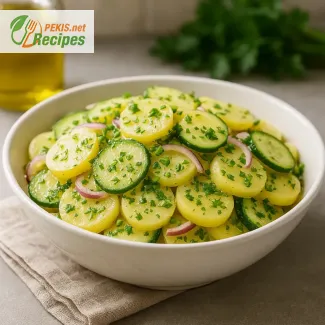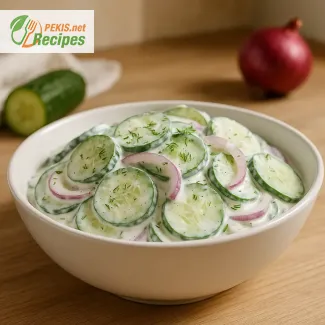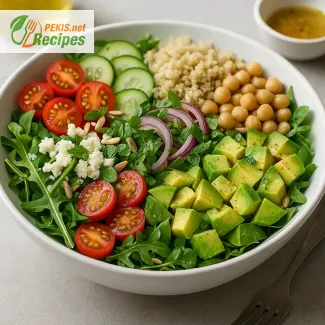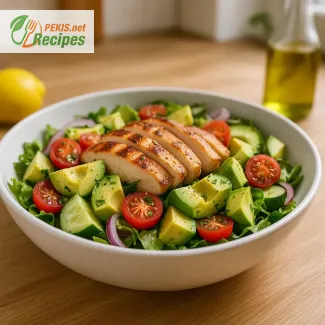
Discover the Flavors of Switzerland with This Summer Potato Delight
A Traditional Warm-Weather Classic from the Heart of Swiss Cuisine
When it comes to alpine culinary traditions, few dishes capture the essence of Swiss home cooking like the Härdöpfelsalat, more commonly known as Swiss potato salad. This light and refreshing dish is especially popular during the warmer months, served at garden parties, family barbecues, and mountain picnics. While each region in Switzerland boasts its own variation, the summer version of this potato salad is distinguished by its vibrant herbs, tangy vinaigrette, and delicate texture that perfectly complements grilled meats or serves as a satisfying vegetarian side.
The name “Härdöpfelsalat” comes from the Swiss German dialect, where “Härdöpfel” simply means potato. Unlike its creamy, mayonnaise-laden counterparts found elsewhere in Europe or North America, the Swiss-style summer potato salad is rooted in simplicity and flavor harmony. It relies on a light, oil-based dressing, often enriched with mild mustard, apple cider vinegar, and clear vegetable broth, resulting in a dish that is both lightweight and deeply flavorful. Thinly sliced red onions, freshly chopped chives, and crunchy cucumbers are often added to bring contrast and freshness to each bite.
What makes this authentic Swiss summer potato salad so appealing is its balance between heartiness and lightness. It’s substantial enough to satisfy hunger, yet light enough to remain refreshing on hot summer days. Served slightly warm or at room temperature, the salad allows its ingredients to fully develop their character, from the tender texture of waxy potatoes to the subtle tang of the dressing. Whether prepared in the city kitchens of Zürich or the rural chalets of Appenzell, this dish is a beloved staple that transcends generations.
Ingredients that Define Alpine Simplicity
Choosing the Right Potatoes
The backbone of any good potato salad is, unsurprisingly, the potato itself. In this case, it’s essential to use waxy varieties, such as Charlotte, Nicola, or Yukon Gold. These potatoes hold their shape after cooking, which ensures the salad doesn’t turn mushy or overly starchy. The texture should be smooth and firm, providing a perfect canvas for the other ingredients to shine.
Mustard, Vinegar, and Broth: The Holy Trinity of Swiss Dressing
Swiss culinary traditions value subtlety over excess, and the dressing in a Swiss potato salad reflects this ethos. A small amount of mild mustard adds depth without overpowering, while apple cider vinegar introduces a gentle tang. The inclusion of warm vegetable broth (often poured over the potatoes while they are still slightly warm) is a traditional technique that allows the flavors to absorb thoroughly, ensuring every slice is infused with taste.
Fresh Herbs and Crisp Vegetables
The finishing touches make all the difference. Chopped chives, parsley, and sometimes tarragon give the salad its signature aromatic lift, while the inclusion of thinly sliced red onions or shallots adds a mellow sharpness. In many summer versions, crisp cucumbers or radishes are incorporated for added crunch and a refreshing bite, enhancing the visual and textural contrast of the dish.
Seasonal Elegance on Every Plate
The authentic Swiss summer potato salad is more than just a side dish—it's a celebration of seasonal ingredients. Its versatility allows it to accompany a wide variety of mains, from grilled sausages and schnitzel to vegetarian quiches and smoked trout. The salad’s ability to complement bold, smoky flavors while standing confidently on its own makes it a must-have on any summer menu.
This recipe embodies the alpine culinary philosophy: use the freshest ingredients available, allow each element to speak for itself, and prepare with care. With just a handful of pantry staples and garden-fresh herbs, it delivers a harmonious blend of texture, flavor, and tradition—qualities that define the best of Swiss home cooking.
In the following section, you’ll find the full recipe for preparing this timeless summer favorite, complete with exact measurements and easy-to-follow steps.
1. Boil the potatoes.
Wash the waxy potatoes thoroughly and boil them in salted water (not listed) for about 20 minutes, or until they are just tender when pierced with a fork. Drain and let them cool slightly until they are warm but not hot.
2. Prepare the broth.
In a saucepan, heat the vegetable broth gently. Stir in the apple cider vinegar, mild mustard, salt, and black pepper until fully combined. Keep the mixture warm.
3. Slice the potatoes.
Once the potatoes are cool enough to handle, peel them if desired and slice them into thin, even rounds or half-moons (about 0.5 cm / ¼ inch thick). Place the warm slices in a large mixing bowl.
4. Pour dressing over the potatoes.
Slowly pour the warm broth mixture over the sliced potatoes. Gently stir to coat all slices. Let the mixture sit for at least 10 minutes to allow the flavors to absorb.
5. Add fresh ingredients.
Finely slice the red onion and cucumber, then chop the chives and parsley. Add all these to the bowl with the potatoes. Pour in the sunflower oil and carefully mix everything together.
6. Final resting.
Let the salad rest at room temperature for another 10–15 minutes before serving. This allows the dressing to soak into the ingredients for a more unified flavor.
7. Serve.
Serve the salad slightly warm or at room temperature. It pairs well with grilled meats, sausages, or as a light vegetarian dish on its own.
Elevating the Härdöpfelsalat: Creative Ways to Refine Swiss Potato Salad
Transforming a traditional dish into a modern classic with simple adjustments
The Swiss summer potato salad (Härdöpfelsalat) is a time-honored favorite, but like many traditional recipes, it offers ample room for culinary creativity. With a few thoughtful tweaks, this rustic Alpine dish can be elevated in flavor, texture, and nutritional profile, all while preserving its authentic spirit. By understanding the role of each ingredient and how subtle changes affect the overall result, home cooks can make this dish uniquely their own.
Additions that enhance flavor and complexity
Upgrade your herbs for deeper aroma
While chives and parsley are standard, introducing fresh dill, basil, or tarragon can bring a new herbal dimension to the salad. Dill adds a slightly anise-like freshness that pairs wonderfully with potatoes and cucumbers, especially in summer. Tarragon, on the other hand, gives the salad a more sophisticated, slightly sweet edge, ideal for serving alongside fish.
Include pickled elements for acidity
To boost brightness and depth, consider adding thinly sliced cornichons or pickled red onions. These bring a sharp acidic contrast that intensifies the natural earthiness of the potatoes and the sweetness of the onions. For a more nuanced umami layer, a spoonful of capers can subtly enrich the vinaigrette.
Nuts and seeds for texture
A sprinkle of toasted sunflower seeds or pumpkin seeds adds crunch and nutritional value, while remaining consistent with the rustic nature of the dish. For a more gourmet twist, crushed hazelnuts or walnuts can lend a warm, nutty aroma and a richer mouthfeel.
Ingredient swaps for better nutrition
Oil variations
Replacing sunflower oil with extra virgin olive oil introduces monounsaturated fats and a more robust, fruity note to the dressing. Olive oil also binds well with mustard and vinegar, creating a smoother emulsion that clings beautifully to the potatoes.
Vinegar upgrades
Instead of standard apple cider vinegar, experimenting with white wine vinegar or even sherry vinegar adds a more layered acidity. Sherry vinegar, in particular, has a rounded flavor with hints of oak and sweetness, giving the salad an elegant boost.
Potato choices and their impact
Using purple potatoes or a mix of red and yellow varieties doesn’t just make the salad more colorful—it introduces different flavor profiles and textures. Purple potatoes are slightly earthier and denser, while red potatoes hold their shape even better after boiling. This not only enhances the visual appeal but also improves mouthfeel variety in each bite.
Why homemade is always superior
A home-prepared potato salad allows for full control over ingredients, seasoning levels, and freshness—factors that can never be fully replicated in store-bought versions. Commercial salads are often loaded with preservatives, refined oils, and excess sodium, all of which diminish the clean, honest flavor of a true Härdöpfelsalat. At home, you can adjust the seasoning to taste, choose organic produce, and assemble the salad just before serving, ensuring optimal texture and temperature.
Common mistakes to avoid
Overcooking the potatoes
One of the most frequent errors is overboiling the potatoes, which makes them break apart during mixing. This turns the salad mushy and unappealing. To avoid this, test the potatoes with a skewer—they should offer gentle resistance and retain shape when sliced.
Adding dressing too early or too late
For best results, pour the warm broth-based dressing over the potatoes while they’re still warm, not hot. If the potatoes are too hot, they will disintegrate; if too cold, they won’t absorb the flavors properly. This balance ensures each piece becomes fully infused without falling apart.
Using starchy potatoes
Opting for starchy varieties like Russets leads to a floury, dry salad. Instead, always use waxy potatoes, which hold their form and soak up the dressing without crumbling.
Ideas for boosting freshness and seasonal flair
During summer, take advantage of seasonal vegetables by adding blanched green beans, asparagus tips, or even thinly shaved fennel. These not only contribute visual contrast but also enhance the salad’s crunch and vibrancy. In early autumn, you can enrich the recipe with roasted beet slices or carrot ribbons for a heartier feel.
A vegan and allergen-friendly approach
This recipe is naturally egg-free and dairy-free, making it ideal for vegans or those with common dietary restrictions. To increase protein content, you might consider adding chickpeas, white beans, or tofu cubes, all of which absorb the dressing well and offer satiety. For those sensitive to mustard, a blend of ground turmeric and lemon juice provides a similar golden color and mild tang.
Make it your signature dish
Ultimately, the beauty of Härdöpfelsalat lies in its adaptability. By respecting its roots while embracing seasonal ingredients and personal flavor preferences, you can turn a familiar side dish into an unforgettable centerpiece. Whether you keep it classic or add your own flair, every variation tells a story—of place, palate, and passion.
Allergens present in the recipe:
- Mustard (mild mustard)
Gluten content:
- Gluten-free (if all ingredients including broth and mustard are certified gluten-free)
Substitution tips to avoid allergens and gluten:
- Mustard substitute: Use a pinch of turmeric or horseradish paste (if tolerated) for color and mild spice.
- Ensure gluten-free broth: Always use certified gluten-free vegetable broth.
Vitamins and minerals per serving (approximate):
- Vitamin C: 18 mg – Supports immune function and skin health
- Vitamin B6: 0.4 mg – Important for metabolism and brain health
- Potassium: 700 mg – Helps regulate blood pressure and nerve function
- Folate: 25 µg – Supports cell growth and red blood cell formation
- Iron: 1.2 mg – Vital for oxygen transport and energy metabolism
- Magnesium: 35 mg – Important for muscle and nerve function
- Calcium: 20 mg – Essential for bones and teeth
Antioxidants per serving (approximate):
- Chlorogenic acid (from potatoes): 18 mg – May support blood sugar balance and reduce inflammation
- Quercetin (from onion): 12 mg – Anti-inflammatory and immune-supportive properties
- Caffeic acid (from parsley): 6 mg – Supports liver detoxification
- Vitamin C (as antioxidant): 18 mg – Protects cells from oxidative stress





